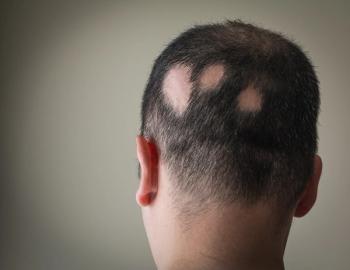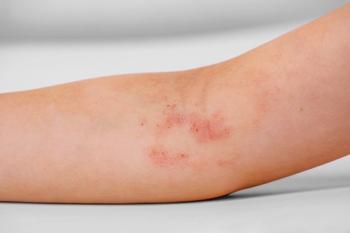
- Consultant for Pediatricians Vol 8 No 7
- Volume 8
- Issue 7
White Patches on a Young Boy's Trunk
A 3-year-old boy with white patches on the trunk first noticed shortly after birth.
HISTORY
A 3-year-old boy with white patches on the trunk first noticed shortly after birth. The lesions appeared to be enlarging with the child's growth. Mother denied any concurrent or preceding symptoms. Child had no developmental delay or visual or hearing deficits, and no history of seizure or abnormal sweating. Family history negative for similar skin disorder or atopic disease. Child was nonatopic.
PHYSICAL EXAMINATION
Healthy-appearing toddler without a white forelock. No systemic signs or symptoms of tuberous sclerosis, craniofacial abnormalities, or additional areas of hypopigmentation. Hair and teeth normal.
Multiple, variable-sized, off-white, hypopigmented, oval to round macules and patches located on the left chest and shoulder to left mid back. The lesions were unilaterally distributed along Blaschko lines, without overlying scale. Wood light examination accentuated the off-white lesions.
WHAT'S YOUR DIAGNOSIS?
(
ANSWER: SEGMENTAL NEVUS DEPIGMENTOSUS
First described in 1884 by Lesser, nevus depigmentosus (ND), or achromic nevus, is a congenital, noninherited, hypopigmented macule or patch that remains stable in relative size and distribution throughout life.1 The lesion is located mainly on the trunk and proximal extremities. There is no predilection among sexes. ND is usually present at birth; however, it may appear later in infancy as normal pigmentation increases. The condition is thought to occur in about 1 in 125 neonates.
There are 3 distinct types of ND:
•Isolated, usually circular or rectangular in shape.
•Segmental, which is generally unilateral and arranged in either a blocklike pattern or along Blaschko lines- as in this patient.
•Systematized, consisting of multiple whorls or streaks.2
Results of electron microscopic studies suggest that the underlying pathology of ND is a developmental defect of the fetal melanocytes, specifically with the transfer of melanosomes from melanocytes to keratinocytes. 2 Although the term “depigmentosus” implies the absence of melanocytes, the quantity of melanocytes in ND is normal or decreased.
Neurological and systemic abnormalities have been reported in patients with ND. The incidence of these abnormalities remains controversial but is thought to be low in isolated and segmental ND. In one study of 20 patients with segmental ND, 2 children were found to have extracutaneous abnormalities: one had mental retardation, hemihypertrophy of limbs, and seizures, and the other had pes cavus ipsilateral to the hypopigmentation.2
DIFFERENTIAL DIAGNOSIS
The finding of a hypopigmented lesion in a child is cause for further investigation. ND can be differentiated from other hypopigmentation disorders through a variety of clinical findings and the patient/family history.
Vitiligo is the most common primary disorder of hypopigmentation, occurring in about 1% of the population. In about 50% of cases, vitiligo develops before age 20 years.3 This acquired, progressive skin condition is characterized by the destruction of melanocytes, which leads to complete depigmentation of the involved area; Wood lamp examination reveals chalk-white accentuation. 4 Areas of hyperpigmentation are often present along the lesion borders.
Vitiligo is classified into 2 forms: generalized and localized segmental. In the segmental form, lesions increase in size for about a year after the initial appearance and remain relatively stable thereafter.5 Differentiating vitiligo from the other disorders of hypopigmentation is especially important because of the prognosis and psychosocial effects associated with this diagnosis.4
Ash-leaf lesion of tuberous sclerosis is a well-circumscribed macule or patch with a partial loss of pigmentation. In most patients, ash-leaf lesions are present at birth, but they can also develop later in childhood. The lesions are most commonly confused with those of isolated ND.5 Without the use of electron microscopy, a solitary ashleaf lesion can be distinguished from ND only by the presence of other signs and symptoms of tuberous sclerosis.
This patient lacked systemic signs and had none of the associated cutaneous features (eg, angiofibromas of the face, shagreen patches), which are present in 98% of patients with tuberous sclerosis.4 The Blaschko line distribution of the lesions also made the diagnosis of tuberous sclerosis less likely.
Pityriasis alba is characterized by patchy hypopigmentation that is frequently accompanied by a fine white scale; there is a predilection for the face.5 This disorder occurs more often in children with a personal or family history of atopy, which this patient lacked. Pityriasis alba also is more apparent in patients with darkerpigmented skin and has indistinct margins.
Hypomelanosis of Ito (previously incontinentia pigmenti achromians) was first described in 1952 by the Japanese dermatologist for whom the disorder is named.6 The lesion is usually present at birth in a bilateral distribution, although it may develop later in childhood and can be unilateral, similar to ND. The hypopigmented areas may increase in size and number during infancy. Like ND, hypomelanosis of Ito has a predilection for the trunk and limbs; the well-circumscribed, macular, linear or whorled areas of hypopigmentation also follow Blaschko lines.2 There is a female predominance of 2.5 to 1. An autosomal dominant inheritance has been observed in some patients.2 One study reported an incidence of 1 in 7805 general pediatric outpatients and 1 in 790 general pediatric dermatology outpatients.7
Systematized ND can be difficult to distinguish from hypomelanosis of Ito in a patient without accompanying systemic abnormalities.5 Some question whether systematized ND is a separate entity from hypomelanosis of Ito. The estimated occurrence of extracutaneous abnormalities in patients with hypomelanosis of Ito is highly variable, ranging from 33% to 94%.8 The associated systemic anomalies are usually neurological, musculoskeletal, or ocular.5 Common manifestations include mental retardation, autism, seizures, macrocephaly, microcephaly, hypotonia, pes valgus, genu valgum, cerebellar hypoplasia, intracranial arteriovenous malformations, distal spinal muscular atrophy, hypertelorism, strabismus, and myopia. Uncommon manifestations include deafness, syndactyly, gynecomastia, short stature, congenital cardiopathies, genital and renal anomalies, and precocious puberty. Rarely, neoplasms have been reported (neuroblastoma and choroid plexus papilloma).9,10
Other hypopigmented lesions, such as postinflammatory hypopigmentation and drug-induced (eg, topical corticosteroid) hypopigmentation, should also be considered in the differential. A thorough history can exclude these diagnoses.
FOLLOW-UP AND FUTURE CONSIDERATIONS
In our patient, the unilateral, Blaschko-line distribution of the off-white hypopigmented lesions pointed toward the diagnosis of segmental ND. The lack of systemic abnormalities or family history of similar disease helped rule out other hypopigmentation disorders.
We recommend further investigation in patients with ND, especially in those with systematized ND, because of the potential for the presence of extracutaneous manifestations. In all patients, it is important to review the family history and monitor the lesions for repigmentation and stability over time. Biopsy may prove useful, and surveillance for the development of systemic findings is warranted.
References:
REFERENCES:1. Sheth PB. Differential diagnosis of vitiligo vulgaris. In: Hann SK, Nordlund JJ,eds. Vitiligo. Oxford, UK: Blackwell Science; 2000:116-117.
2. Di Lernia V. Segmental nevus depigmentosus: analysis of 20 patients. PediatrDermatol. 1999;16:349-353.
3. Bolognia JL, Pawelek JM. Biology of hypopigmentation. J Am Acad Dermatol.1988;19:217-255.
4. Lee HS, Chun YS, Hann SK. Nevus depigmentosus: clinical features and histopathologiccharacteristics in 67 patients. J Am Acad Dermatol. 1999;40:21-26.
5. Pinto FJ, Bolognia JL. Disorders of hypopigmentation in children. PediatrClin North Am. 1991;38:991-1017.
6. Küster W, König A. Hypomelanosis of Ito: no entity, but a cutaneous sign ofmosaicism. Am J Med Genet. 1999;85:346-350.
7. Ruiz-Maldonado R, Toussaint S, Tamayo L, et al. Hypomelanosis of Ito: diagnosticcriteria and report of 41 cases. Pediatr Dermatol. 1992;9:1-10.
8. Ruggieri M, Pavone L. Hypomelanosis of Ito: clinical syndrome or just phenotype? J Child Neurol. 2000;15:635-644.
9. Oguma E, Aihara T, Shimanuki Y, et al. Hypomelanosis of Ito associated withneuroblastoma. Pediatr Radiol. 1996;26:273-275.
10. Zajac V, Kirchhoff T, Levy ER, et al. Characterisation of X;17(q12;p13) translocationbreakpoints in a female patient with hypomelanosis of Ito and choroidplexus papilloma. Eur J Hum Genet. 1997;5:61-68.
Articles in this issue
over 16 years ago
Hip Pain in a Teenaged Girlover 16 years ago
Bashful Baby Testiclesover 16 years ago
Distract ToddlersWith DummyBandagesover 16 years ago
Reversibility of TPN-Induced Cholestasisover 16 years ago
Frey Syndromeover 16 years ago
Pityriasis Lichenoides Et Varioliformis Acuta in a 7-Year-Old Boyover 16 years ago
Acute Urticariaover 16 years ago
“Syndrome” or “Sequence”? Not Just a Matter of SemanticsNewsletter
Access practical, evidence-based guidance to support better care for our youngest patients. Join our email list for the latest clinical updates.














